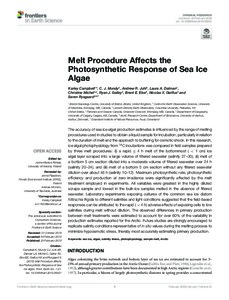| dc.contributor.author | Campbell, Karley | |
| dc.contributor.author | Mundy, C. J. | |
| dc.contributor.author | Juhl, Andrew R. | |
| dc.contributor.author | Dalman, Laura A. | |
| dc.contributor.author | Michel, Christine | |
| dc.contributor.author | Galley, Ryan J. | |
| dc.contributor.author | Else, Brent E. | |
| dc.contributor.author | Geilfus, Nicolas X. | |
| dc.contributor.author | Rysgaard, Søren | |
| dc.coverage.spatial | Arctic Ocean | en_US |
| dc.date.accessioned | 2019-07-26T01:37:47Z | |
| dc.date.available | 2019-07-26T01:37:47Z | |
| dc.date.issued | 2019 | |
| dc.identifier.citation | Campbell, K, ; Mundy, C.J.; Juhl, A.R.;
Dalman, L.A.; Michel, C.; Galley, R.J.;
Else, B.E.; Geilfus, N.X. and Rysgaard, S.
(2019) Melt Procedure affects
the Photosynthetic Response of Sea
Ice Algae. Frontiers in Earth Science, 7:21, 14p. DOI:10.3389/feart.2019.00021 | en_US |
| dc.identifier.uri | http://hdl.handle.net/11329/991 | |
| dc.identifier.uri | http://dx.doi.org/10.25607/OBP-523 | |
| dc.description.abstract | The accuracy of sea ice algal production estimates is influenced by the range of melting
procedures used in studies to obtain a liquid sample for incubation, particularly in relation
to the duration of melt and the approach to buffering for osmotic shock. In this research,
ice algal photophysiology from 14C incubations was compared in field samples prepared
by three melt procedures: (i) a rapid 4 h melt of the bottommost ( < 1 cm) ice
algal layer scraped into a large volume of filtered seawater (salinity 27–30), (ii) melt of
a bottom 5 cm section diluted into a moderate volume of filtered seawater over 24 h
(salinity 20–24), and (iii) melt of a bottom 5 cm section without any filtered seawater
dilution over about 48 h (salinity 10–12). Maximum photosynthetic rate, photosynthetic
efficiency and production at zero irradiance were significantly affected by the melt
treatment employed in experiments. All variables were greatest in the highly diluted
scrape sample and lowest in the bulk-ice samples melted in the absence of filtered
seawater. Laboratory experiments exposing cultures of the common sea ice diatom
Nitzschia frigida to different salinities and light conditions suggested that the field-based
responses can be attributed to the rapid ( < 4 h) adverse effects of exposing cells to low
salinities during melt without dilution. The observed differences in primary production
between melt treatments were estimated to account for over 60% of the variability in
production estimates reported for the Arctic. Future studies are strongly encouraged to
replicate salinity conditions representative of in situ values during the melting process to minimize hypoosmotic stress, thereby most accurately estimating primary production. | en_US |
| dc.language.iso | en | en_US |
| dc.rights | Attribution 4.0 International | * |
| dc.rights.uri | http://creativecommons.org/licenses/by/4.0/ | * |
| dc.subject.other | Algae | en_US |
| dc.subject.other | Salinity stress | en_US |
| dc.subject.other | Photophysiology | en_US |
| dc.subject.other | Sample melt | en_US |
| dc.title | Melt Procedure Affects the Photosynthetic Response of Sea Ice Algae. | en_US |
| dc.type | Journal Contribution | en_US |
| dc.description.refereed | Refereed | en_US |
| dc.format.pagerange | 14pp. | en_US |
| dc.identifier.doi | 10.3389/feart.2019.00021 | |
| dc.subject.parameterDiscipline | Parameter Discipline::Biological oceanography::Macroalgae and seagrass | en_US |
| dc.bibliographicCitation.title | Frontiers in Earth Science | en_US |
| dc.bibliographicCitation.volume | 7 | en_US |
| dc.bibliographicCitation.issue | Article 21 | en_US |
| dc.description.sdg | http://purl.unep.org/sdg/SDGIO_00000048 | en_US |
| dc.description.eov | Sea Ice | en_US |
| dc.description.bptype | Guide | en_US |
| dc.description.frontiers | 2018-10-01 | |
| obps.contact.contactname | Karley Campbell | |
| obps.contact.contactemail | kc17823@bristol.ac.uk | |
| obps.resourceurl.publisher | https://www.frontiersin.org/articles/10.3389/feart.2019.00021/full | en_US |
 Repository of community practices in Ocean Research, Applications and Data/Information Management
Repository of community practices in Ocean Research, Applications and Data/Information Management

